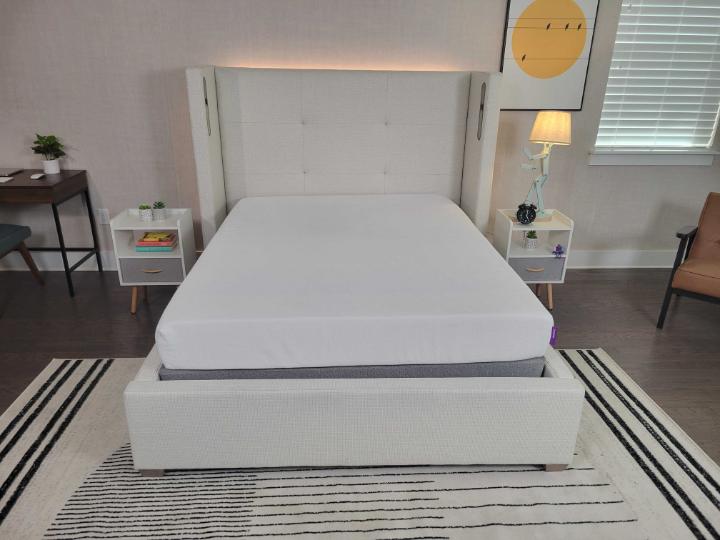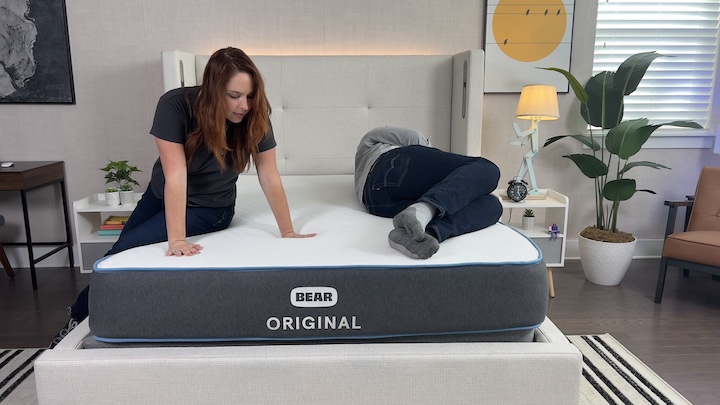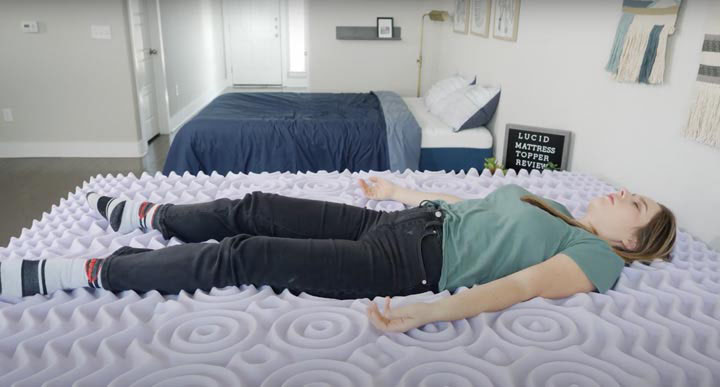If you’re looking to improve your sleep, buying a mattress or new sleep product can be a daunting process. You want something that’s going to be comfortable, affordable, and work for your unique needs. But where to start? That’s where we come in.
At Mattress Clarity, we aim to make the buying experience a breeze. Our reviews give you the need-to-know information that will help you find the right product for you. We test each product we recommend in our dedicated testing studio, spending 30 to 60 minutes doing a “nap test” (testers don’t fall asleep every time) on mattresses and bedding. We then use our proprietary analysis to determine factors like feel, quality, cooling, and a whole lot more.
Take a look below for detailed information on our review process for mattresses, pillows, sheets, blankets, and sleep tech.
Where We Test
Welcome to the mattress house! Here, we have tested over 150 mattresses and 200 accessories. Downstairs, we test mattresses and compare them to one another. Upstairs, we thoroughly assess sheets, pillows, blankets, and sleep tech. New products arrive all the time, so we are able to keep up with the latest product releases and mattress trends.

How We Review Mattresses
Testing a mattress isn’t as straightforward as simply taking a nap on it. Our team of reviewers assess each bed’s pressure relief, edge support, motion isolation, temperature control, and more. Here’s a closer look at how we measure each component.
Firmness
We test every mattress in our studio and try it out in multiple sleeping positions. Based on our experience, we rate mattresses on a scale of 1-10, with 1 being extremely soft and plush and 10 being extremely firm. Our team consists of reviewers with different body types, and we also take into account how your size and weight can affect the firmness of your mattress.
In addition, we break out how a bed’s firmness will affect its fit for different sleeping positions. Back sleeping, is the mattress a perfect medium-firm that offers a balance of comfort and support? Side sleeping, is the mattress soft enough to relieve pressure on our shoulders and hips? Stomach sleeping, is it a firm mattress that holds up our hips?
Body Weight
Mattresses are very subjective. For example, a heavier person may think a mattress feels firmer than a smaller person does. That’s why we get a wide variety of perspectives when we review mattresses for body weight.
Marten, who is 6’7,” takes naps on every mattress we review. He assesses how it feels when he rests on his side, back, and stomach. Then, Elisa, who is 5’3,” does the same thing. Oftentimes, the reviewers’ experiences differ slightly. When we publish the final review, we include both Marten and Elisa’s experiences.

Pressure Relief
We test each mattress to see just how pressure-relieving it is. Lying down in all three sleeping positions, do we feel a build-up of pressure around our joints, or is the mattress easing this pressure?
Pressure relief is especially important for side sleepers. When you sleep on your side, your weight is concentrated on your shoulders and hips. If a mattress doesn’t relieve pressure, you will feel some discomfort in those areas. We mostly focus on this position during our pressure relief tests.

Cooling
Many mattresses feature cooling features meant to prevent sleepers from overheating during the night. If the mattress features latex or coils, we know it’s going to be a cooling mattress, as these materials naturally promote airflow. While memory foam mattresses are known for trapping heat, some brands infuse foam with gel, graphite, or copper. These can help with heat dissipation and make a mattress feel cool to the touch.
And, of course, we try out the mattress for ourselves. After napping for 60 minutes, are these materials truly cool to the touch? When we wake up, are we hot and sweaty, or are we feeling nice and cool?
Learn more about how we test the cooling capabilities of a mattress.
Edge Support
Edge support is another factor that sleeping partners should keep in mind. A mattress with solid edge support lets sleepers utilize every inch of the mattress. This means partners can sleep all the way toward the edge without rolling or falling off.

We test each mattress’s edge support by sitting and lying down near its edge. If it collapses under our weight, the mattress doesn’t have excellent edge support. If it holds us up while we sit and lie down, we know this will be a good mattress for couples.
Motion Isolation
We run a few tests in order to assess a mattress’s motion isolation. First, we place a glass of water on one side of the bed and then attempt to make a disturbance on the other side. If there is no disturbance in the water, the mattress is isolating motion very well. If there is a good bit of disturbance in the water, motion is transferring across the mattress.

Second, one of our reviewers lies down on one side of the mattress while another reviewer rolls around on the other side, changes positions, and gets in and out of bed. This is meant to mimic what a sleeping partner might do during the night. If the first reviewer is undisturbed on their side of the mattress, the mattress is isolating motion well.
Learn more about how we test and rate mattresses for motion isolation.
Ease of Movement
We test each mattress by rolling around on it and changing positions. If it is a slow-moving memory foam mattress, we may feel great pressure relief but will have trouble moving around. If it is a bouncy latex mattress, it will be easier to move around on, but we won’t feel as much contouring or pressure relief. We also use this test to assess whether a mattress is good for sex.
Off-Gassing
When you open a new bed-in-a-box mattress, you may notice a slight chemical smell. It often takes about 48 hours for this odor to dissipate.
When we test bed-in-a-box mattresses, we pay close attention to the strength of this odor and how long it takes for it to fade away. We’ve noticed that, in general, all-foam mattresses take longer to off-gas than innerspring beds. All-natural latex mattresses tend to have a “barnyard” smell for the first few days.
Here’s more information about how we test off-gassing, and what you can do to get rid of the “new mattress smell.”
How We Review Sleep Accessories
Just like mattresses, we give all of our sleep accessories a test drive. Most of the sleep accessories reviewed at Mattress Clarity include pillows, sheets, weighted blankets, mattress toppers, and miscellaneous sleep technology.
We evaluate these sleep accessories on different factors. In our testing process for pillows, sheets, blankets, and mattress toppers, we make sure to give them a 30 to 60 minute nap test after getting a general feel for the products. Below we’ll discuss how our product testers, Tony Klespis and Elisa Regulski review various Mattress & Sleep accessories.
Pillows
Fill Materials
Here at Mattress Clarity we cover four main types of pillows: down, down alternative, memory foam, and latex foam pillows. Down, down alternative, and latex pillows are ready to use right out of the box, so our testing processes start the second we get them. Memory foam pillows might be compressed, so they’ll need to expand and off-gas.
Memory foam and latex foam pillows can be shredded or single pieces. This doesn’t change the feel of them too much, but we’ll discuss how this plays a role below. There are more than just these four types of pillows, and we’ve discussed a list of 15 different types.

Cooling
Some pillows are made out of materials that prevent them from trapping heat, like cooling gel and breathable foam. Latex is a rather breathable material on its own, but we also look for perforations in the foam which can allow for airflow. The shredded versions of these pillows are also more breathable than their single piece counterparts.
When it comes to down and down alternative pillows, these fill materials are rather breathable, but we pay attention to the outer cover. Pillows with these fills tend to have cotton covers, which is very breathable and prevents the pillow from trapping heat.
Firmness & Support
When it comes to testing the firmness of a pillow, we start by getting an overall feel. This usually looks like us squeezing the pillow and seeing how much pressure it can take to get it as flat as possible. The more effort we put into squeezing the pillow, the firmer the pillow usually is. Then we move on to the sleeping positions.
We test pillows in back, side, and stomach sleeping positions to measure how much support a pillow can provide for that sleeping position. Some pillows work for all sleeping positions because the inner fill can be adjusted. If that’s the case, we make sure to test the pillows by removing or configuring the pillow to work best for each position.

Sheets
Materials
Feel is an important part of the sheet buying process. And the way sheets feel comes down to the materials used and how they’re woven. There are a variety of sheet materials, but the most common types we test at Mattress Clarity are:
- Cotton
- Bamboo
- Tencel lyocell
- Polyester
- Linen
The feel is also influenced by the weave style. The two weave styles are percale and sateen. Percale sheets feel crisp, while sateen sheets feel soft and satin-like. Cotton can be woven with both styles, and we typically see sateen for bamboo and Tencel.
Cooling
Testing sheets for their cooling ability usually happens during the nap test. Depending on the material, thickness, and weave style, some sheets promote airflow better than others. Bamboo, cotton, Tencel, and linen are very breathable and sometimes moisture-wicking materials that are good for keeping people cool.

Fit
Fitted sheets have a variety of depths in their pockets. Deep-pocket sheets can range anywhere from 13” to 17”, and most sheets we test fall within this range. However, the testing process does involve us getting in and out of bed and changing positions. Some mattresses are taller than others, so testing out the fitted sheet to see if it won’t shift too much, or if the pockets won’t pop up is crucial.
Blankets
Weight
Most of the blankets we test at Mattress Clarity are weighted blankets. Weighted blankets come in a variety of sizes, and while what you should get is up to personal preference, shoppers need to know the options available. This is particularly important for those that haven’t bought a weighted blanket before.
We tend to test blankets that are intended for an average-weight person (we consider this weight range anywhere from 130 to 230 lb), and the blankets usually weigh around 15 lb. An ideal weighted blanket will weigh about 10% of a sleeper’s body weight. Many of the blankets we test are available in multiple weights, so sleepers can find one that works for their size.

Temperature Regulation
Some weighted blankets have ways to regulate temperature. Considering they can be quite warm and cozy, shoppers may be keen for a way to prevent overheating. We look at the breathability of materials and keep an eye out for cotton or bamboo, which are naturally cooling. Some weighted blankets have constructions that allow for airflow, such as an open-knit structure.
Mattress Toppers
Firmness Adjustment
The goal of a mattress topper is to change the firmness and feel of your mattress. Generally, people want toppers to soften their mattress, but some people may want to make their mattress feel more supportive. We test each topper on top of a mattress to see how it changes its firmness. We assess the firmness of the mattress on our 1-to-10 firmness scale, then place the topper on top and reassess. Most toppers soften mattresses by 1-2 points.

Fit
Some toppers have covers, others don’t. Most toppers are true to the mattress size, but some might not stay in place, even under a fitted sheet. We test the fit by moving around on the topper to see how much the topper shifts, if at all. Toppers with outer covers, silicone grips, and straps tend to feel secure and stable.
Cooling
Just like mattresses, some toppers utilize cooling innovations to prevent you from overheating. This can come in the form of gel-infused foam, perforations that allow for airflow, or cooling outer covers that can pull body heat away from you.
Sleep Tech
From sleep trackers to sunrise alarm clocks, the Mattress Clarity team has reviewed a wide variety of sleep tech. This testing methodology differs from our mattress and bedding review process. Keep reading for a peek inside our testing studio:
Testing Period
Because each product is different, the testing period can range from one to 30 days. Many sleep trackers, such as ShutEye and RISE, require at least one week of data to fully understand how the product works. Other products, like the Loftie alarm clock, only need to be used for a night or two for us to fully evaluate its quality and usefulness. When we tested the Calm and Headspace apps, we spent a month with each program in order to understand how the meditation sessions impacted our sleep.

Construction
When testing products like air purifiers, humidifiers, and alarm clocks, we thoroughly investigate the construction and materials. Many budget-friendly alarm clocks work well, but because they’re made out of thin plastic, they won’t have a long lifespan. We make sure to relay the most thorough information to consumers so they can find the product that works best for their lifestyle.
Usability
Sleep tech products always come with thorough directions, but are they easy to follow? Does it take a long time to understand how the product works? How easy is it to assemble? When we test sleep tech, we always assess its ease of use and assembly.
Price
After thoroughly inspecting the product, we have one more question to answer: “Is it worth the price?” Many products have high price points, but because they’re made with durable materials, they might be worth splurging on. Other products may have budget-friendly price tags, but won’t last as long.
Meet the Reviewers
The Mattress Clarity team is passionate about helping people get the best night’s sleep possible. Here’s a little bit more infomation about your friendly neighborhood mattress reviewers.
Marten, Lead Reviewer

Marten Carlson has reviewed over 500 mattresses and written more than 400 articles about bedding, mattresses, and sleep health. He’s a combination sleeper who loves helping people find the perfect mattress for their unique needs. He has a bachelor’s degree in Film Production from Denison University and a master’s degree in Film Studies from Emory University.
Elisa, Editor

Elisa Regulski is an editor of Mattress Clarity, and she has reviewed over 150 mattresses and 75 sleep accessories. She’s a side sleeper who values a supportive, high-loft pillow. She has a B.F.A in acting from Oklahoma City University and a M.A in mass communication from Texas State University. When she’s not writing and editing articles about mattresses and bedding, she is singing nostalgic tunes with Saved By The 90s and interviewing bands for Music Capital.
Tony, Sleep Accessories Reviewer

Tony Klespis is Mattress Clarity’s resident sleep accessories expert and has reviewed over 200 products. He’s a Certified Sleep Science Coach who loves sharing his thorough product knowledge with readers. He has a B.A in english with a creative writing minor from Sam Houston State University and a M.A in mass communication from Texas State University.